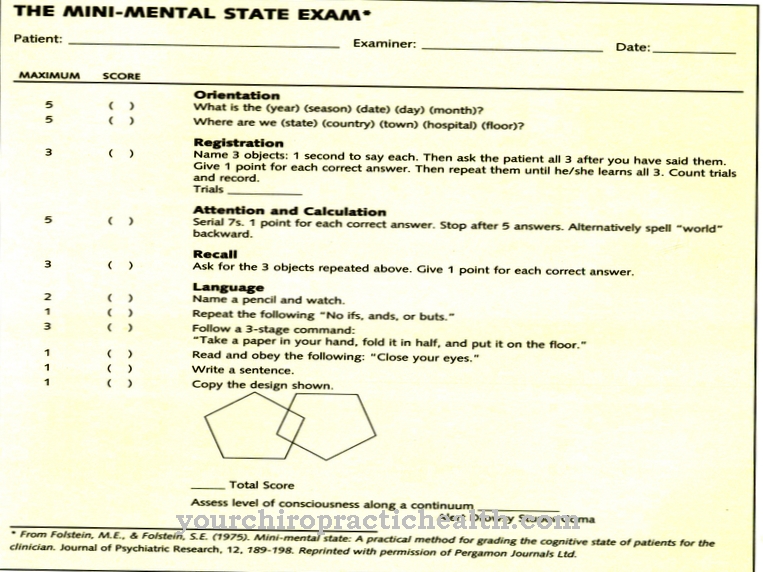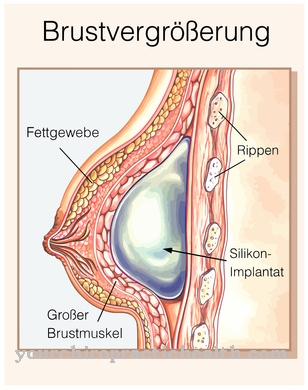Joints can be damaged or instable by various diseases or an accident. In such cases, a joint replacement is often recommended Endoprosthesis required. This can restore the mobility of the joint and avoid pain.
What is the endoprosthesis?

Endoprostheses are artificial joints that replace a damaged joint and remain in the body as an implant. For this purpose, the worn joint is removed under anesthesia and replaced with an artificial joint. Endoprostheses are often used for hip and knee joints, less often for ankle, elbow or finger joints.
When replacing the complete joint, one Total endoprosthesis, short TEP, spoken. Depending on the extent of the damage, only certain parts of the joint can be replaced. The partial joint replacement of the hip, in which, for example, only the joint head is replaced, is called Hemiendoprosthesis or short HEP, in the case of a partial endoprosthesis, there is also a Sled prosthesis spoken.
Function, effect & goals
Osteoarthritis, gout or rheumatic diseases can damage joints. Other causes include an accident or a bone fracture, a misalignment of the joint or, in rare cases, bacterial inflammation. Tumors that appear near joints can also cause damage.
Depending on the degree of destruction or impairment of function and if no other therapy options are available, joint replacement with an endoprosthesis may be necessary. Likewise, in old age, natural wear and tear can make the use of an endoprosthesis necessary. Under general or partial anesthesia, damaged joint parts are removed and the remaining bone is milled to fit the endoprosthesis. Then the implant is inserted and fixed. The endoprosthesis is made of metal, plastic or ceramic or, in the case of a TEP, a combination of these materials. A distinction is made between cemented and cementless prostheses, and there are also so-called hybrid prostheses in which parts are cemented and other areas are cement-free.
Cementing, which uses a fast-setting plastic, makes the artificial joint easier to insert and fix. With the cementless prosthesis, the joint is precisely fitted and fixed by the body through the formation of new bone substance. Wound pain occurs in the first few days after the operation and is treated with medication. Physiotherapy exercises for the mobility of the joint can be performed on the first day after the operation. Only with a cement-free endoprosthesis should there be no or only partial loading in the first week after the operation until the implant is sufficiently fixed by the newly formed bone substance.
For hip and knee endoprostheses, forearm crutches are required in the first few weeks after the operation. These prevent overloading of the operated joint and improve safety when taking your first steps. The inpatient stay usually lasts about a week before rehabilitation measures with physiotherapy exercises improve mobility and the muscles that stabilize the joint are trained. Regular follow-up examinations at the orthopedic surgeon or in the clinic are necessary in order to detect possible complications at an early stage and to ensure the long-term function of the artificial joint.
The endoprosthesis takes over the function of the replaced joint, mobility is restored and pain is eliminated. This increases the quality of life, patients can go back to their work and do hobbies and sports. Since endoprostheses do not have an unlimited lifespan, the use of the artificial joint is mainly chosen for older patients. However, depending on the clinical picture, implantation of an endoprosthesis can make sense at a young age. The lifespan of an artificial hip or knee joint is now 15 to 20 years, whereby heavy loads can significantly shorten the lifespan.
Risks, side effects & dangers
With an endoprosthesis, the risks associated with an endoprosthesis are comparable to those of other operations: a thrombosis can occur during or after the operation, infections can lead to impaired wound healing, a bruise can form after the operation or bleeding can occur.
Nerves or blood vessels can also be injured, and there is occasional blood loss during the surgery, requiring a blood transfusion. Specific risks for a joint endoprosthesis are in rare cases the splintering of bone tissue. These make additional stabilization necessary, for which wires or screws are used. If an allergic reaction to one of the components of the endoprosthesis occurs, the joint must be replaced again. The artificial joint may loosen during the first ten years after the implant has been inserted.
This change, associated with pain and instability, sometimes inflammatory, requires another operation. In addition, the friction of the prosthesis on the joint surface can cause the prosthesis to wear off, which can trigger inflammatory reactions. In what is known as heterotropic ossification, the body converts soft tissue into bony tissue and, without countermeasures, the joint mobility obtained by the operation is lost.
When exercising, joint-gentle sports such as cycling, hiking or swimming should be preferred. Sports with sudden stop and rotation movements such as squash should be avoided. However, the exercise of sport also depends on the type of endoprosthesis and the form in which a sport is carried out. Breaststroke swimming is not suitable for hip replacement, but crawl or backstroke swimming is harmless.
Typical & common joint diseases
- arthrosis
- Joint inflammation
- Joint pain
- Joint swelling
- Rheumatoid arthritis



























